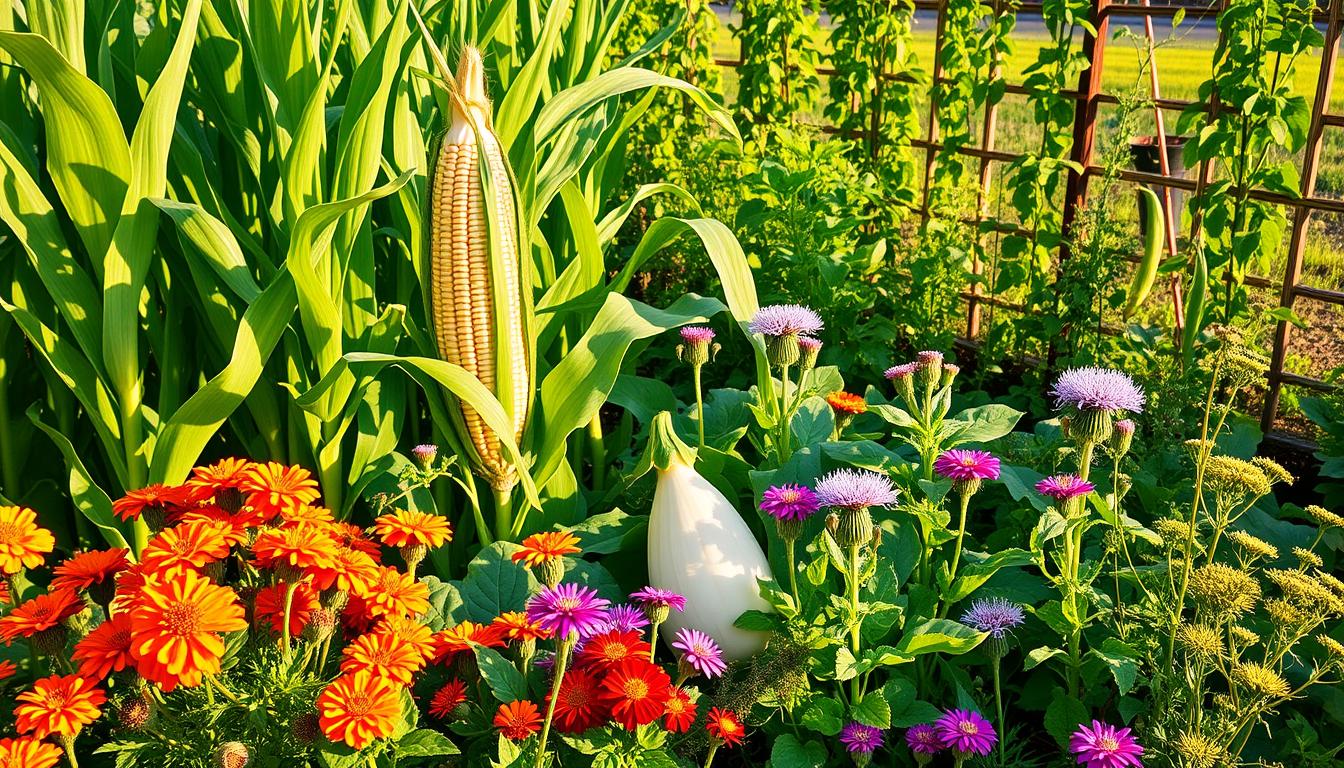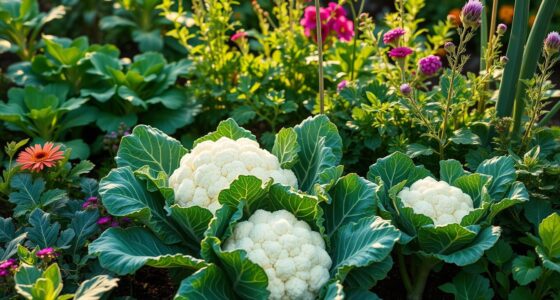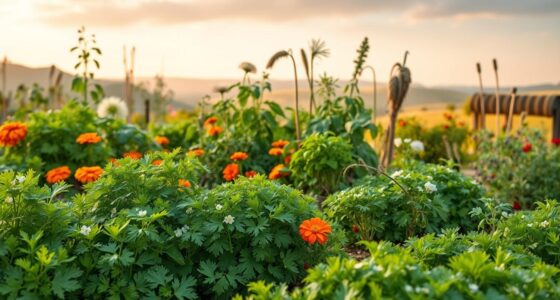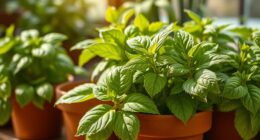Have you ever stood in your garden, watching your plants thrive in harmony, feeling a sense of peaceful connection with nature? Growing corn can be a rewarding experience, not just for the delightful ears it produces, but for the vibrant ecosystem that flourishes alongside it. In the world of gardening, discovering the best corn companion plants transforms your garden into a nurturing sanctuary, allowing each plant to contribute to the health and well-being of its neighbors. Companion planting with corn isn’t just a clever strategy; it’s a heartfelt commitment to fostering a garden where every leaf and stem plays a vital role. Let’s explore the top 10 corn companion plants that can elevate your gardening journey.
Key Takeaways
- Understanding the concept of corn companion plants can enhance your garden.
- The right companions can boost nutrient uptake and soil health.
- Companion planting with corn helps with natural pest control.
- Growing diverse plants supports a resilient garden ecosystem.
- Implementing companion planting strategies can lead to healthier yields.
What Are Companion Plants for Corn?
Companion planting refers to the practice of growing different plants in proximity for mutual benefit, particularly in a corn garden. Understanding the dynamics of planting companions for corn can greatly enhance your gardening efforts. By choosing specific plants that complement corn, you can create a thriving ecosystem that encourages growth and health.
Importance of Companion Planting
Companion planting plays a crucial role in optimizing the garden environment. It fosters a balanced ecosystem that supports plant health and growth. When you select suitable corn garden companions, you reduce competition for essential resources such as water and nutrients. Furthermore, many companion plants deter pests that could harm your corn, contributing to a healthier garden overall.
Benefits of Companion Planting for Corn
The corn companion planting guide reveals numerous benefits. Plants that thrive alongside corn can improve soil nutrients, enhance moisture retention, and provide shade. Specific combinations can lead to higher yields and better resistance to pests. Embracing the right planting companions for corn not only yields productive crops, but it also cultivates a more resilient garden.

Top 10 Corn Companion Plants
Understanding the best corn companion plants enriches your gardening experience and enhances your corn’s growth. The symbiotic relationships established between corn and its companions can lead to improved health and yield. Below is a detailed look at some of the most beneficial partners in the garden.
1. Beans: A Perfect Match
Beans serve as optimal companions for corn, thanks to their ability to fix nitrogen in the soil. This nutrient enrichment supports corn’s growth. The support structure provided by corn stalks helps beans grow taller and stronger, creating a mutually beneficial environment. These corn plant companions truly thrive together.
2. Squash: The Triad Effect
Squash is a significant part of the traditional “Three Sisters” planting method. When paired with corn and beans, squash spreads out and provides ground cover. This cover prevents weeds, maintains soil moisture, and offers a natural barrier against pests. These attributes make squash one of the best corn companion plants.
3. Tomatoes: Boosting Flavor and Growth
Tomatoes complement corn by attracting beneficial insects that help protect both plants. Their unique growing habits contribute to a diverse garden environment. Although more complex in care, tomatoes support an increase in yield for both plants, providing excellent synergy in growth.
4. Peppers: Enhancing Protection
Peppers share space well with corn, providing shade and leaving room for airflow. They help deter some pests that may threaten corn, creating a protective hedge around your crop. Their vibrant colors also add beauty to your garden while enhancing the overall health of your corn plant companions.
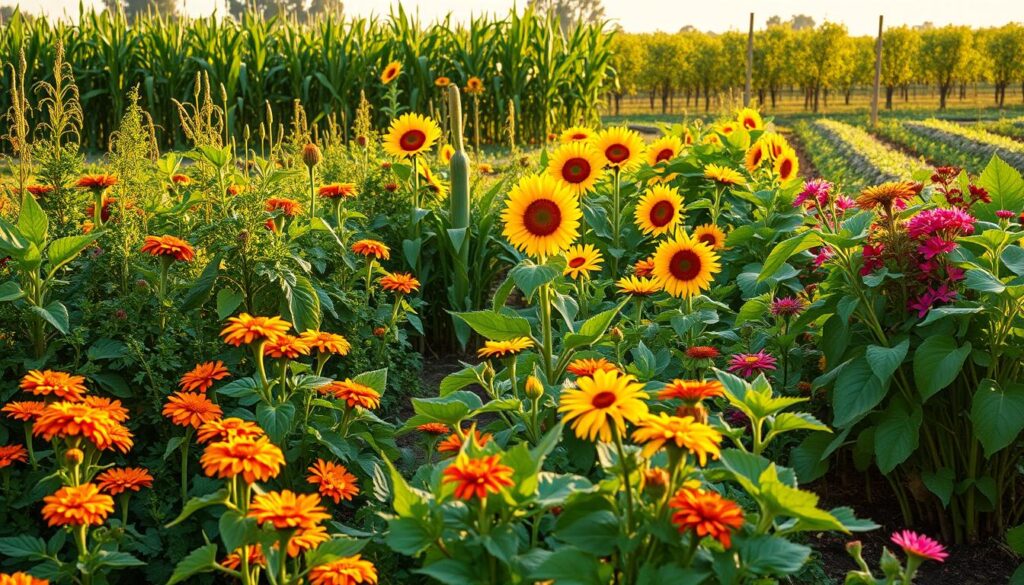
| Companion Plant | Benefits | Growth Interaction |
|---|---|---|
| Beans | Nitrogen fixation | Tall support structure |
| Squash | Weed control | Ground cover and moisture retention |
| Tomatoes | Attracts beneficial insects | Diverse planting environment |
| Peppers | Pest deterrence | Provides shade and airflow |
Why Certain Plants Pair Well with Corn
Corn companion planting thrives on understanding how various plants interact and support one another. Selecting the right corn vegetable garden companions can significantly enhance your corn’s growth and resilience. Through nutrient relationships and pest management strategies, finding the ideal pairings can lead to a flourishing vegetable garden.
Exploring Nutrient Relationships
Leguminous plants, such as beans, play a crucial role in corn companion planting. These plants fix nitrogen in the soil, enriching it and providing essential nutrients for corn. This partnership not only promotes robust growth but also minimizes the need for synthetic fertilizers.
Below is a table showcasing some of the most effective nutrient relationships between corn and its companions:
| Companion Plant | Nutrient Benefit | Growth Enhancement |
|---|---|---|
| Beans | Increases nitrogen levels | Supports corn growth and yields |
| Squash | Suppresses weeds | Shields soil moisture |
| Sunflowers | Improves soil structure | Enhances light availability |
Pest and Disease Management
Strategic corn companion planting serves an essential purpose in pest and disease management. By creating a diverse planting scheme, certain plants can attract beneficial insects that help control pest populations. For instance, marigolds, often planted alongside corn, emit scents that deter harmful insects.
Incorporating a mix of plants can result in a thriving ecosystem, ultimately leading to healthier crops. By understanding these relationships, you can create a harmonious garden that benefits your corn and its companions throughout the growing season.
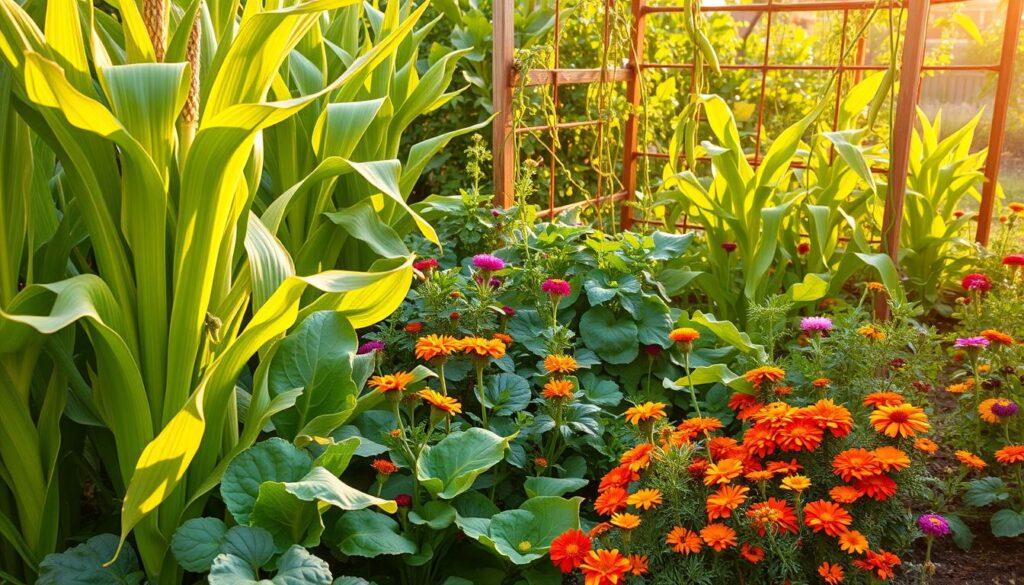
Best Growing Conditions for Corn Companions
Creating the ideal environment for your plants boosts the success of companion planting with corn. Understanding the best growing conditions for corn companions is crucial for achieving a flourishing garden. This section discusses the essential soil requirements, sunlight needs, and watering practices that contribute to healthy growth.
Soil Requirements
Corn companions thrive in various soil types, but there are common characteristics that conducive to strong growth. Generally, these plants prefer well-draining soil rich in organic matter. A pH level between 6.0 and 7.0 is often optimal. Adding compost can enhance soil structure and fertility, supporting the plants’ nutritional needs.
Sunlight Needs
Sunlight plays a vital role in the development of corn and its companions. Most companion plants require full sun exposure, meaning at least six hours of direct sunlight each day. Remember that as corn grows taller, it can provide shade for shorter plants. This allows for a diverse microclimate, benefiting various crops.
Watering Practices
Proper watering is crucial for maintaining moisture levels without causing waterlogged conditions. Corn and many companion plants prefer consistent moisture, particularly during their growing season. Aim for deep watering sessions that encourage strong root growth, but be attentive to drainage to avoid oversaturation. Monitoring both rainfall and temperature can help you adjust your watering schedule accordingly.
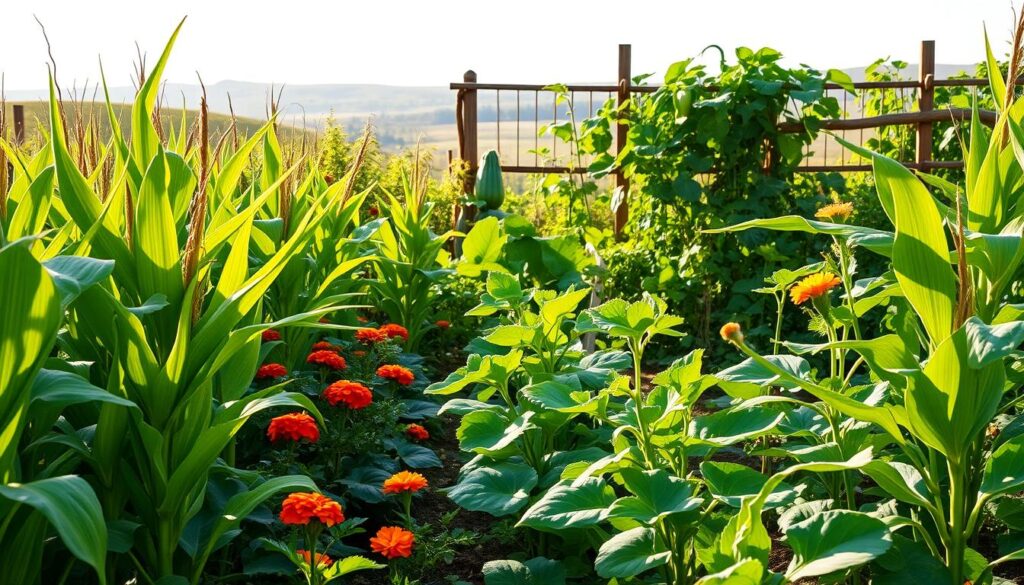
How to Plan Your Companion Planting Layout
Effective planning plays a significant role in achieving success in your garden. When following a corn companion planting guide, you can maximize resources such as sunlight, water, and nutrients. A strategic layout ensures the optimal growth of your plants and allows you to benefit from interplanting with corn.
Spatial Arrangement of Plants
Careful consideration of the spatial arrangement of plants is essential for effective companion planting. It promotes airflow, reduces competition for nutrients, and optimizes light exposure. Here are a few tips to help you arrange your plants effectively:
- Group compatible plants together to enhance their synergistic relationships.
- Ensure enough space between plants to avoid overcrowding, which can lead to poor growth.
- Plant taller crops, such as corn, at the back or center of the garden to prevent shading shorter companions.
Companion Planting Charts
Using companion planting charts can offer a visual guideline for spacing and arrangements. These charts often display the best companion plants for corn and indicate optimal distances based on their growth patterns. Below is a sample chart that illustrates some ideal pairings along with recommended spacing:
| Companion Plant | Recommended Spacing (inches) | Benefit |
|---|---|---|
| Beans | 12-15 | Fix nitrogen in the soil |
| Squash | 24-36 | Shade the ground to prevent weeds |
| Tomatoes | 18-24 | Enhances flavor and growth |
| Peppers | 12-18 | Improves protection against pests |
By carefully planning your companion planting layout and utilizing charts, you can create an efficient garden that harnesses the full potential of interplanting with corn. With these techniques, your plants will thrive, leading to a bountiful harvest.
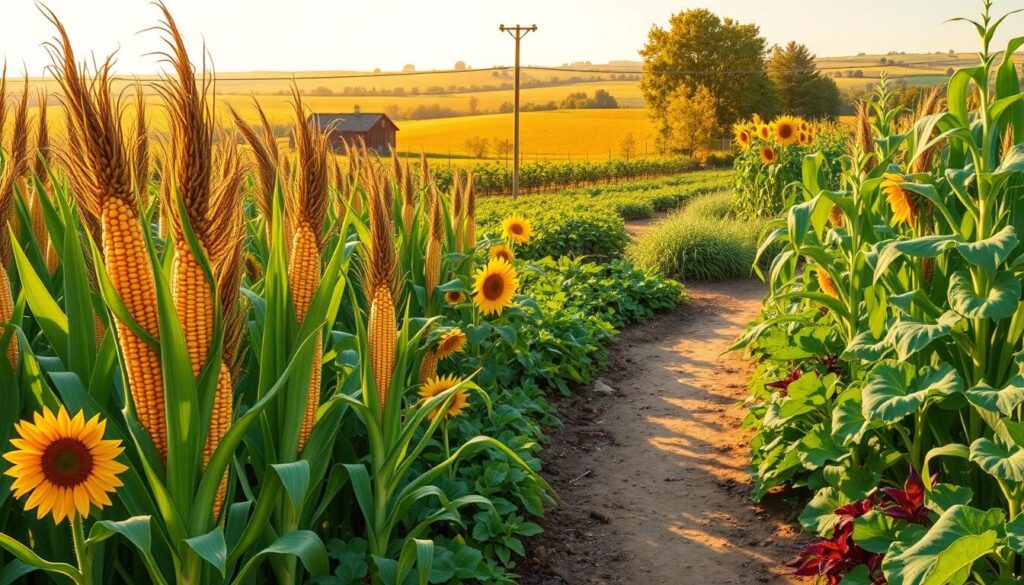
Common Mistakes in Companion Planting
Understanding the dynamics of corn companion plants is essential for a successful garden. While the idea of planting companions can enhance growth and combat pests, there are common mistakes in companion planting that can hinder progress. Recognizing these pitfalls can save you time and effort while maximizing your harvest.
Overcrowding Plants
One of the biggest mistakes in companion planting is overcrowding. When you plant too many varieties in one space, they compete for essential resources such as sunlight, nutrients, and water. This competition can stunt their growth, leading to poor yields. To ensure each plant thrives, arrange your corn companion plants with adequate spacing that aligns with their mature sizes.
Ignoring Growth Patterns
Another significant error is ignoring the specific growth patterns of each plant. Different companions have varying heights, root depths, and light requirements. For instance, tall plants can overshadow shorter ones, blocking sunlight and limiting their growth potential. Always consider how each plant develops and tailor your planting strategy to promote harmony in your garden space.

Timing Your Planting for Success
Getting the timing right in your corn vegetable garden companions can significantly enhance your yields and overall garden health. Understanding when to plant corn and its companions optimizes their growing conditions, ensuring they get the best start possible. Here, we will delve into the ideal planting schedules and seasonal considerations that can make a difference in your companion planting strategy.
When to Plant Corn and Companions
Timing is crucial for successful gardening. For corn, you generally want to wait until the soil temperature reaches at least 60°F. This ensures germination occurs effectively. Planting corn alongside its companions like beans and squash can elevate success by staggering their planting schedules to avoid competition for resources. For instance:
| Plant | Ideal Planting Time | Notes |
|---|---|---|
| Corn | Late spring | Soil temperature above 60°F |
| Beans | After corn is planted | Benefit from corn’s structure for support |
| Squash | Once corn is about 6 inches tall | Requires ample space to spread |
Seasonal Considerations
Seasonal factors greatly influence the timing of your planting and the success of corn vegetable garden companions. For example, consider your region’s climate:
- Frost Dates: Always check for local frost dates to prevent damage to young plants.
- Moisture Levels: Ensure adequate moisture is present as corn and its companions have varying needs.
- Sun Exposure: Most of these plants thrive in full sun, monitor shading effects as they grow.
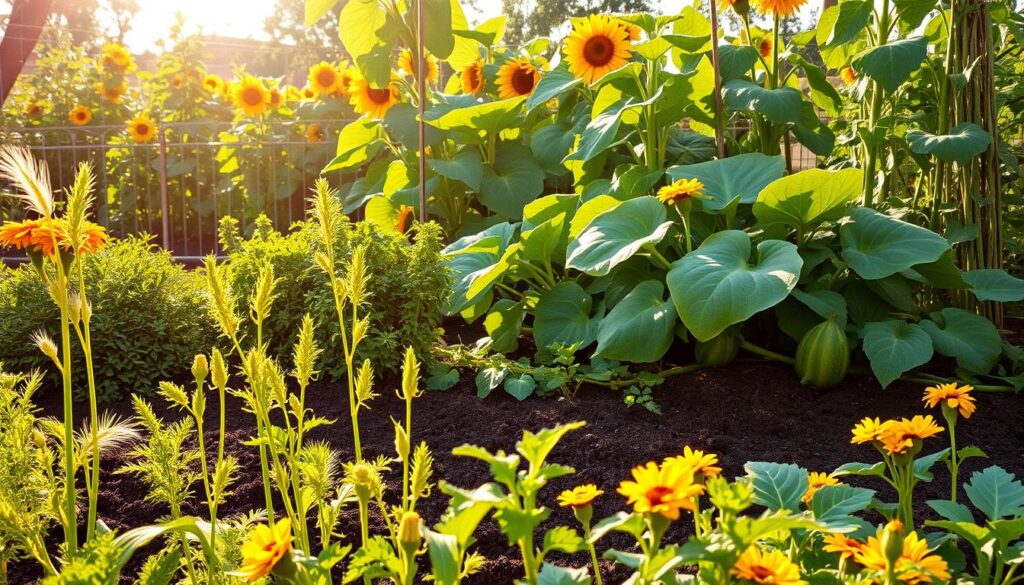
By carefully planning your timing for companion planting, you create a thriving ecosystem that captures the benefits of each plant. Bringing together the right companions at the right time maximizes your chances of a bountiful harvest.
Care and Maintenance of Corn Companions
Ongoing care and maintenance of corn companions play a significant role in achieving a successful harvest. Ensuring that both corn and its companion plants flourish requires attention to proper fertilization and pest control techniques. These practices help sustain garden health and optimize crop yield.
Fertilization Tips
Effective fertilization strategies are crucial for the health of corn companion plants. Use a balanced fertilizer that promotes strong growth while minimizing nutrient leaching. Organic options like compost or well-aged manure provide essential nutrients. Applying these fertilizers during the early growth stages helps establish robust plants that can support one another throughout the growing season.
Pest Control Strategies
Incorporating specific corn companion plants can provide natural pest management solutions. For instance, marigolds are known to repel harmful insects, while basil attracts beneficial pollinators. Regularly monitor your garden for signs of pests, and take prompt action when necessary. Using organic insecticides, when required, can further enhance the protection of your corn and its companions without harming the beneficial organisms flourishing in your garden.
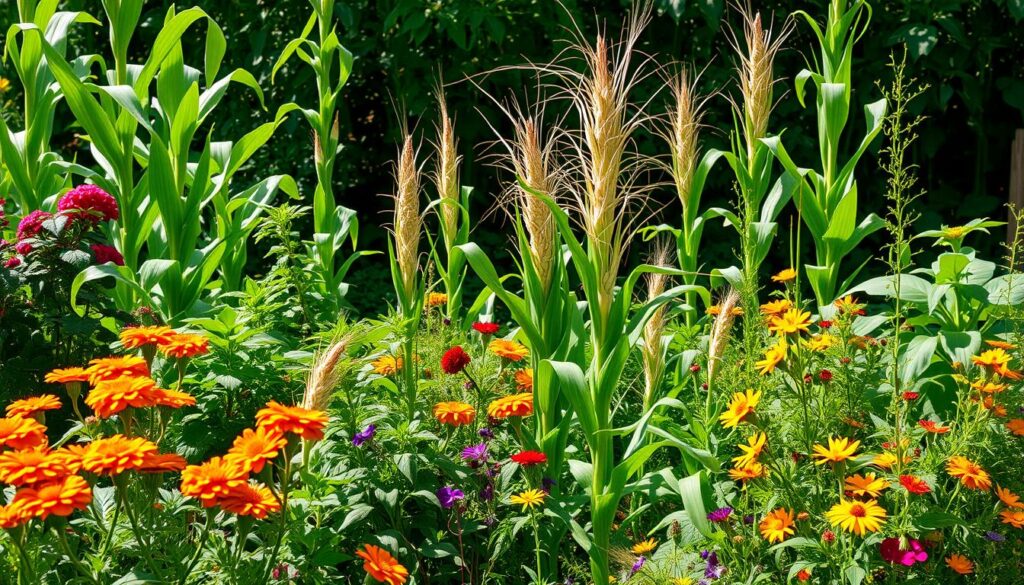
Harvesting Tips for Your Corn and Companions
Knowing when to harvest is vital for maximizing flavor and yield. Look for various signals for corn readiness to determine the perfect time to enjoy your crop. Watching not just the corn but also your harvesting corn companions will enhance your overall gardening experience.
Signs of Ripeness
Identifying the right moment to harvest can be quite straightforward. Keep an eye out for the following signs to ensure your corn and its companions are at their peak:
- Kernel Color: For sweet corn, kernels should be plump and milky, while field corn should have a firm yellow hue.
- Husk Dryness: The husk turns brown and dry, a clear indicator that your corn is mature.
- Silk Color: Brown or dry silk suggests ripeness, ready to be harvested.
- Plant Height: A well-grown plant often indicates healthy corn companions, influencing overall crop productivity.
Best Time for Harvest
The timing of your harvest plays a crucial role in the quality of the produce. The best time to harvest corn typically aligns with the following factors:
- Early morning when temperatures are cooler, which helps preserve flavor and freshness.
- On dry days to minimize moisture content, enhancing storage potential.
- Once the husks have become dry yet still slightly green to protect the ears.
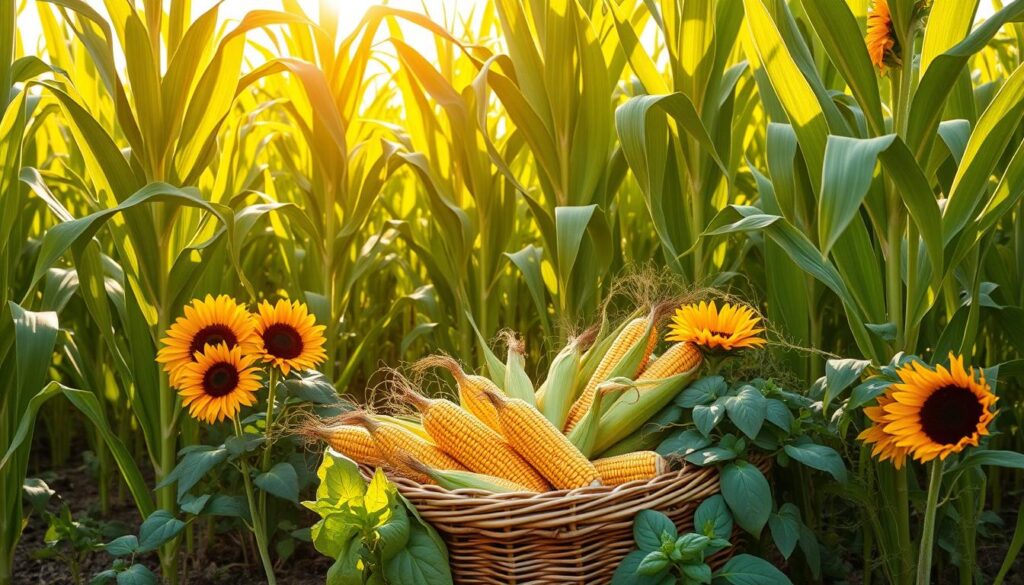
Using Companion Plants for Pest Control
Integrating companion plants into your corn garden can significantly enhance natural pest management. This approach minimizes reliance on chemical pesticides while promoting a healthier ecosystem. By strategically selecting companion plants, you can create a sanctuary that attracts beneficial insects and repels harmful pests.
Natural Pest Deterrents
Certain plants are celebrated for their ability to act as natural pest deterrents for corn. For instance, marigolds deter aphids and nematodes, while garlic is effective against a broad range of pests. Incorporating these plants around your corn can create a protective barrier, allowing your primary crops to thrive.
Attracting Beneficial Insects
Using companion plants for pest control also involves attracting beneficial insects such as ladybugs and lacewings. Flowers like umbellifers (e.g., dill and cilantro) serve as magnets for these helpful creatures, which can significantly reduce pest populations. Positioning these beneficial plants nearby ensures that your corn plants remain protected while enjoying the advantages of a balanced ecosystem.
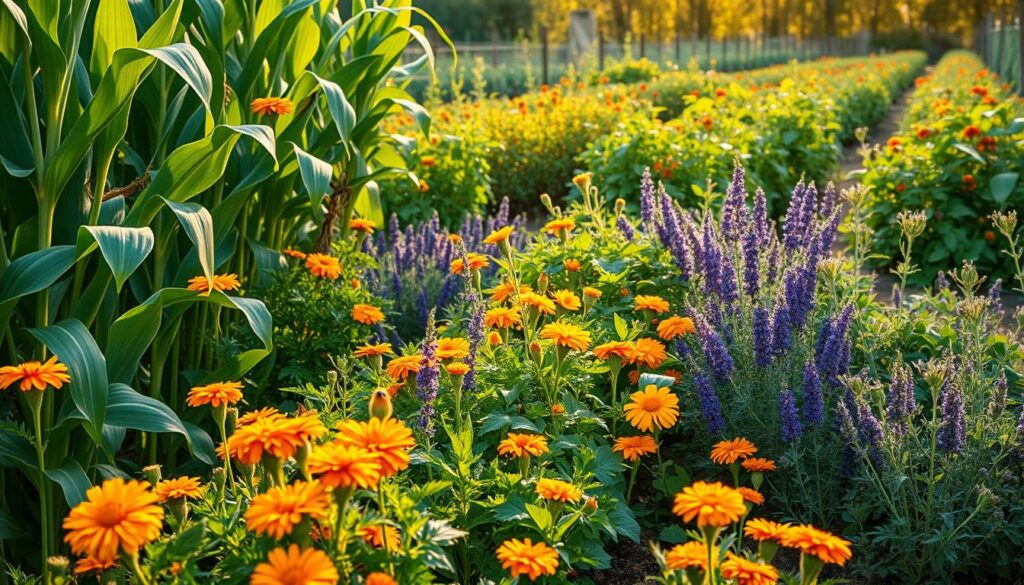
Enhancing Soil Health with Companion Plants
Companion planting for soil health plays an essential role in creating a vibrant ecosystem within your garden. By strategically selecting plants that support one another, you can promote a healthy environment that fosters growth and fertility. Two key aspects to focus on are nitrogen fixation and soil structure improvement.
Nitrogen Fixation Benefits
Nitrogen-fixing plants, such as legumes, can significantly contribute to enhancing soil health. These plants have a unique ability to convert atmospheric nitrogen into a form that is accessible to other plants. By including nitrogen-fixers in your garden, you create a natural nutrient cycle that boosts the overall fertility of your soil. This is especially beneficial for corn as it thrives in nitrogen-rich environments.
Soil Structure Improvement
In addition to nitrogen fixation, companion plants can enhance soil structure. Deep-rooted plants help to break up compacted soil, allowing for better water infiltration and root development. The organic matter from decomposing companion plants adds nutrients and improves soil texture, which prevents erosion and promotes healthier growth for all your garden inhabitants. Embracing companion planting for soil health leads to a more resilient garden that can withstand natural challenges.

Ornamental Companion Plants: Beauty Meets Function
Integrating ornamental plants as companions in your corn garden enhances not only the visual allure but also provides beneficial functions. Choosing the right vibrant flowers can attract pollinators, contributing to the overall health of your crops while elevating the garden’s aesthetic appeal. The combination of beauty and function in companion planting can create a flourishing ecosystem.
Choosing Colorful Additions
When selecting ornamental plants for corn companions, prioritize those that bring both color and utility. Consider flowers such as:
- Marigolds: Their bright blooms deter pests and create a cheerful display.
- Zinnias: Attract butterflies and other pollinators while adding a vibrant touch to your garden.
- Sunflowers: Tall and striking, they provide shade as well as stunning flowers, attracting beneficial insects.
These options not only enhance the beauty of your garden but support the functionality of your corn crops by inviting valuable pollinators.
Attracting Pollinators
Ornamental plants play a critical role in attracting pollinators, which are essential for successful corn growth. The presence of flowers encourages bees and butterflies to visit, ensuring better pollination for your corn. Implementing a selection of ornamental plants for corn companions can lead to improved yields and healthier crops. Flowers such as:
- Lavender: This fragrant plant attracts a variety of pollinators and adds beauty with its purple hues.
- Cosmos: Their long-lasting blooms bring charm while luring important insects to your garden.
- Bee Balm: Known for its vibrant colors and ability to attract bees, it brings both beauty and function to your space.
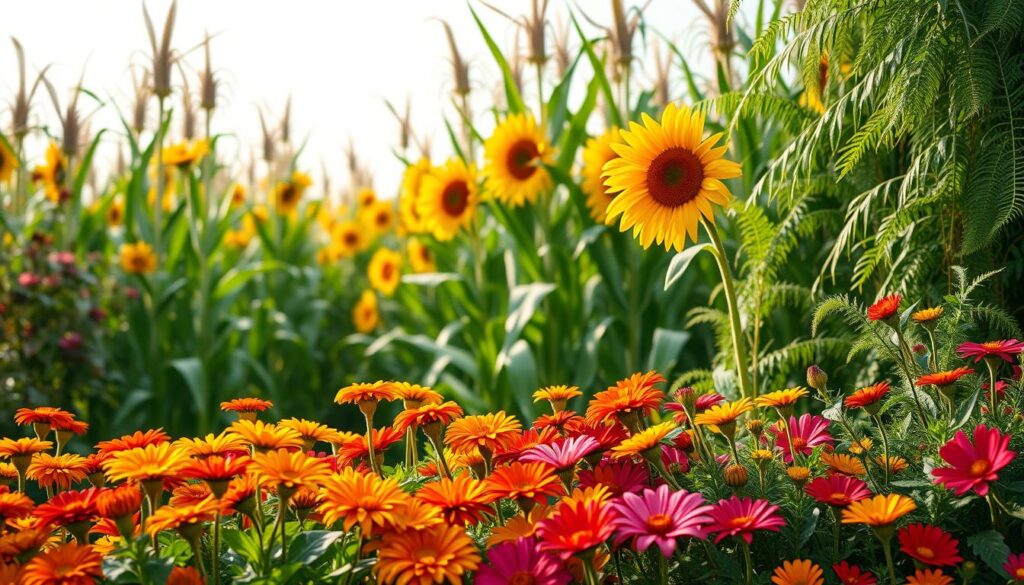
Incorporating these plants enriches your garden’s ecosystem and enhances the synergy between beauty and function in companion planting.
Understanding the Science Behind Companion Planting
Companion planting encompasses a fascinating interplay of botanical relationships that contribute to sustainable gardening practices. Understanding the science behind companion planting reveals how plants interact on various levels, forming beneficial partnerships. Through investigating these interactions, you gain insights into methods that can enhance your gardening success.
Allelopathy: The Good and Bad
Allelopathy in gardening refers to the chemical interactions between plants that can either promote or inhibit growth. Some plants release compounds into the soil that benefit their neighbors by suppressing weeds or repelling pests. Conversely, certain plants may emit toxins that hinder the growth of others. Recognizing the positive and negative effects of allelopathy allows you to create a thriving garden ecosystem where plants effectively support each other.
Cooperative Growth Benefits
In the world of companion planting, cooperative growth benefits showcase the advantages that arise when compatible plants grow together. Plants like corn and beans exemplify this partnership; beans provide nitrogen to the soil, which corn utilizes for healthy growth. This mutual support not only maximizes space but also optimizes nutrient usage. By fostering these relationships, you can cultivate a more productive and resilient garden.
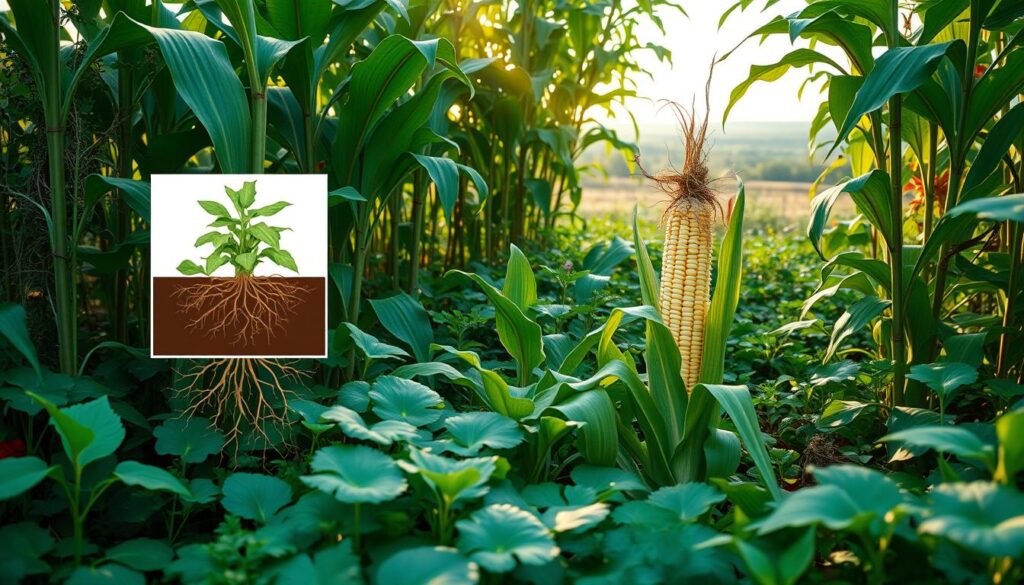
Conclusion: Your Companion Planting Journey
As you embark on your new gardening adventure, it’s crucial to recap the essential points surrounding the benefits and relationships of top corn garden companions. From the nutrient-sharing capabilities of beans to the pest-repelling properties of marigolds, these plants work synergistically with your corn to create an environment conducive to thriving harvests. Understanding these dynamics will empower you in your quest for a bountiful corn crop, which is the ultimate goal of starting companion planting.
Now that you’re equipped with the knowledge of which plants best support corn, you’re ready to roll up your sleeves and get started with your garden today! Consider creating a diverse planting layout that nurtures not just your corn but also the companion plants you select. Engaging with your garden in this way will not only yield great produce but will also enrich your gardening experience, making it all the more pleasurable.
